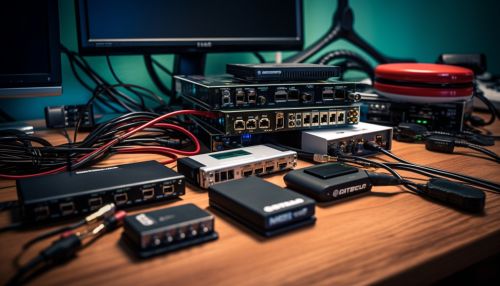Network infrastructure
Introduction
Network infrastructure refers to the hardware and software resources of an entire network that enable network connectivity, communication, operations and management of an enterprise network. It provides the communication path and services between users, processes, applications, services and external networks/the internet.
Components of Network Infrastructure
The network infrastructure is typically made up of several key components. These include:
- Hardware: This includes routers, switches, LAN cards, wireless routers, cables, etc. The hardware is used to make the physical connection between networked devices.


- Software: This includes network operating systems, firewall, network security applications, and network management software. The software is used to manage and control the network, as well as to provide security measures.
- Network Services: These are the services that are provided over the network. They include IP addressing, DNS, DHCP, SMTP (for email), and FTP (for file transfer).
Types of Network Infrastructure
There are several types of network infrastructure, each designed to serve different needs. These include:
- Local Area Networks (LANs): These are networks that are confined to a relatively small area, such as a single building or a group of buildings. They are typically used to connect personal computers and workstations in offices or factories to share resources (like printers) and exchange information.
- Wide Area Networks (WANs): These are networks that cover a large geographical area, often a country or continent. They are used to connect smaller networks together, so that users and computers in one location can communicate with users and computers in other locations.
- Metropolitan Area Networks (MANs): These are networks that connect users and their devices in a geographical area that spans a city or suburb. MANs are larger than LANs but smaller than WANs.
- Virtual Private Networks (VPNs): These are networks that use the internet to provide remote offices or individual users with secure access to their organization's network.
Network Infrastructure Design
The design of a network infrastructure depends on the size and needs of the organization, the type of data that will be transmitted, and the security requirements. The design process typically involves the following steps:
- Topology Design: This involves deciding on the physical and logical layout of the network. The physical layout refers to the actual layout of the network hardware, while the logical layout refers to how the network appears to the devices that use it.
- Protocol Selection: This involves deciding on the protocols that will be used on the network. Protocols define the rules for communication on the network.
- Network Architecture: This involves designing the network's architecture, which includes the hardware, software, and protocols that will be used.
- Security Planning: This involves planning for the security of the network, including the use of firewalls, encryption, and other security measures.
Network Infrastructure Management
Network infrastructure management involves the administration and management of the network hardware, software, and services. This includes:
- Network Monitoring: This involves monitoring the network for problems and performance issues. This can be done using network management software and tools.
- Maintenance: This involves maintaining the network hardware and software. This includes updating software, replacing faulty hardware, and performing routine checks on the network.
- Troubleshooting: This involves diagnosing and resolving network problems. This can be done using network troubleshooting tools and techniques.
- Security Management: This involves managing the security of the network. This includes implementing security measures, monitoring for security breaches, and responding to security incidents.
Conclusion
Network infrastructure is a critical component of any organization's IT strategy. It provides the foundation for all networked services and applications, and its design, management, and security are crucial for the smooth operation of the organization.
